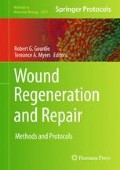Abstract
In vivo wound healing experiments remain the most predictive models for studying human wound healing, allowing an accurate representation of the complete wound healing environment including various cell types, environmental cues, and paracrine interactions. Small animals are economical, easy to maintain, and allow researchers to take advantage of the numerous transgenic strains that have been developed to investigate the specific mechanisms involved in wound healing and regeneration. Here we describe three reproducible murine wound healing models that recapitulate the human wound healing process.
Access this chapter
Tax calculation will be finalised at checkout
Purchases are for personal use only
References
Ramsey SD, Newton K, Blough D, McCulloch DK, Sandhu N, Reiber GE, Wagner EH (1999) Incidence, outcomes, and cost of foot ulcers in patients with diabetes. Diabetes Care 22:382–387
Davidson JM (1998) Animal models for wound repair. Arch Dermatol Res 290(Suppl):S1–S11
Galiano RD, Michaels J, Dobryansky M, Levine JP, Gurtner GC (2004) Quantitative and reproducible murine model of excisional wound healing. Wound Repair Regen 12:485–492
Reddy M, Gill SS, Rochon PA (2006) Preventing pressure ulcers: a systematic review. JAMA 296:974–984
Wassermann E, van Griensven M, Gstaltner K, Oehlinger W, Schrei K, Redl H (2009) A chronic pressure ulcer model in the nude mouse. Wound Repair Regen 17:480–484
Stadler I, Zhang RY, Oskoui P, Whittaker MS, Lanzafame RJ (2004) Development of a simple, noninvasive, clinically relevant model of pressure ulcers in the mouse. J Invest Surg 17:221–227
Peirce SM, Skalak TC, Rodeheaver GT (2000) Ischemia–reperfusion injury in chronic pressure ulcer formation: a skin model in the rat. Wound Repair Regen 8:68–76
Author information
Authors and Affiliations
Editor information
Editors and Affiliations
Rights and permissions
Copyright information
© 2013 Springer Science+Business Media New York
About this protocol
Cite this protocol
Chen, J.S., Longaker, M.T., Gurtner, G.C. (2013). Murine Models of Human Wound Healing. In: Gourdie, R., Myers, T. (eds) Wound Regeneration and Repair. Methods in Molecular Biology, vol 1037. Humana Press, Totowa, NJ. https://doi.org/10.1007/978-1-62703-505-7_15
Download citation
DOI: https://doi.org/10.1007/978-1-62703-505-7_15
Published:
Publisher Name: Humana Press, Totowa, NJ
Print ISBN: 978-1-62703-504-0
Online ISBN: 978-1-62703-505-7
eBook Packages: Springer Protocols

